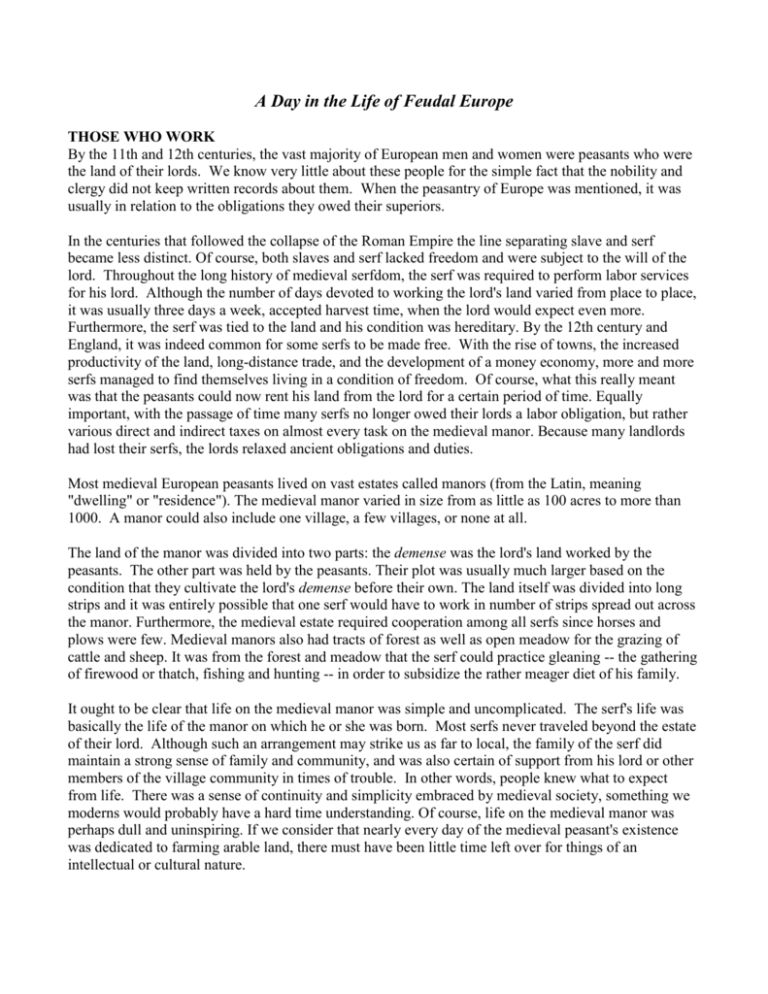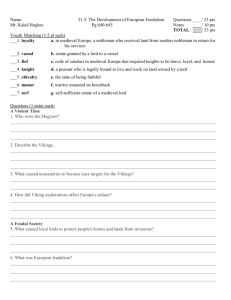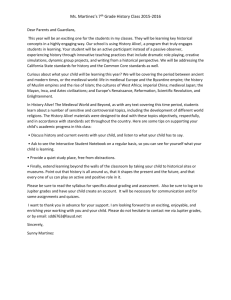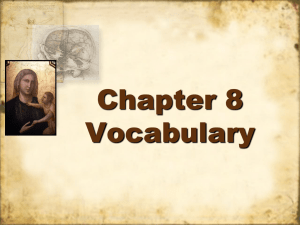File - Miss v`s history class
advertisement

A Day in the Life of Feudal Europe THOSE WHO WORK By the 11th and 12th centuries, the vast majority of European men and women were peasants who were the land of their lords. We know very little about these people for the simple fact that the nobility and clergy did not keep written records about them. When the peasantry of Europe was mentioned, it was usually in relation to the obligations they owed their superiors. In the centuries that followed the collapse of the Roman Empire the line separating slave and serf became less distinct. Of course, both slaves and serf lacked freedom and were subject to the will of the lord. Throughout the long history of medieval serfdom, the serf was required to perform labor services for his lord. Although the number of days devoted to working the lord's land varied from place to place, it was usually three days a week, accepted harvest time, when the lord would expect even more. Furthermore, the serf was tied to the land and his condition was hereditary. By the 12th century and England, it was indeed common for some serfs to be made free. With the rise of towns, the increased productivity of the land, long-distance trade, and the development of a money economy, more and more serfs managed to find themselves living in a condition of freedom. Of course, what this really meant was that the peasants could now rent his land from the lord for a certain period of time. Equally important, with the passage of time many serfs no longer owed their lords a labor obligation, but rather various direct and indirect taxes on almost every task on the medieval manor. Because many landlords had lost their serfs, the lords relaxed ancient obligations and duties. Most medieval European peasants lived on vast estates called manors (from the Latin, meaning "dwelling" or "residence"). The medieval manor varied in size from as little as 100 acres to more than 1000. A manor could also include one village, a few villages, or none at all. The land of the manor was divided into two parts: the demense was the lord's land worked by the peasants. The other part was held by the peasants. Their plot was usually much larger based on the condition that they cultivate the lord's demense before their own. The land itself was divided into long strips and it was entirely possible that one serf would have to work in number of strips spread out across the manor. Furthermore, the medieval estate required cooperation among all serfs since horses and plows were few. Medieval manors also had tracts of forest as well as open meadow for the grazing of cattle and sheep. It was from the forest and meadow that the serf could practice gleaning -- the gathering of firewood or thatch, fishing and hunting -- in order to subsidize the rather meager diet of his family. It ought to be clear that life on the medieval manor was simple and uncomplicated. The serf's life was basically the life of the manor on which he or she was born. Most serfs never traveled beyond the estate of their lord. Although such an arrangement may strike us as far to local, the family of the serf did maintain a strong sense of family and community, and was also certain of support from his lord or other members of the village community in times of trouble. In other words, people knew what to expect from life. There was a sense of continuity and simplicity embraced by medieval society, something we moderns would probably have a hard time understanding. Of course, life on the medieval manor was perhaps dull and uninspiring. If we consider that nearly every day of the medieval peasant's existence was dedicated to farming arable land, there must have been little time left over for things of an intellectual or cultural nature. Of all the characteristics of medieval peasant society that European historians have discussed over the last several decades, none was perhaps more important than the Christian religion as practiced by ordinary men and women. Unlike the practice of religion today, medieval men and women saw Christian belief and practice permeate all aspects of everyday life. In other words, Christianity was a matrix of ideas and modes of behavior not easy to dislodge from the mind set of medieval men and women. The village Church was the center of the medieval community. Nearly all of the important events in the short life of medieval men and women took place within the confines of the Church or churchyard. A person was usually baptized within hours of birth. Men and women confessed their sins to the priest and received the sacraments of Eucharist on Holy Days. There were also feasts that accompanied baptisms, weddings and generals, and were held in the churchyard. The village priest also read messages from secular and Church authorities. Popular medieval religion was shot through with rituals and symbolism. For instance, before slicing bread a woman would tap the sign of the cross on it with her knife. The entire calendar was created with reference to many Holy Days. Everyone participated in village processions. But what did Christianity mean to the medieval peasant? For the most part, they accepted what their family, and custom, and the village priest had told them. Although the mass was in Latin, the priest delivered sermons, usually on the Gospel, in the vernacular. Paintings and stained-glass windows on the walls of the church offered the meaning of biblical stories. Peasants had a strong sense of the existence of God, believing that God was directly involved in human affairs and could reward the virtuous. Of course, they believed that God punished men and women for their sins with disease, plague, poor harvest, and war. The Devil seemed to be everywhere, forcing people to commit evil deeds and thoughts. In general, the life of evil men and women who lived off the land was short and hard. But life in the village community did entail cooperation and the values of a simple life. Although these people did not have the luxuries which the 21st century has bequeathed upon us, they did have a life that was regular and consistent and shot through with a singularity of purpose. THOSE WHO FIGHT: Knights The nobility influenced all aspects of medieval politics, economics, religion, and culture. It is perhaps for this reason alone that European society from about the 12th century on may be termed aristocratic. Although the nobility of medieval Europe varied from place to place, and from time to time, a few general conclusions can be made. As the second Estate, the medieval nobility had special legal status. A man who was a member of the nobility was free in his person and in his possessions. His only limitation concerned his military obligation to his lord. As a member of the nobility, he had certain rights and responsibilities: he could raise troops and command them in the field, he held his own courts of justice, he could coined his own money. He was the lord of all those people who settled on his land. The medieval nobility was, of course, was an Estate of warriors -- those who fight. His social function was to protect the weak and the poor. And this was to be accomplished with a horse and a sword, the two visible signs of his nobility. He was also encouraged to display the virtues of chivalry, a code of conduct created by the clergy to curb the brutality of this order of knights. When a young member of the nobility finally came into possession of his property, he acquired authority over land and people. The nobility rarely lived up to this standard. The reasons for this may be that the nobility wanted immediate gratification. The problem was, there were many times when the nobility were not involved in warfare either with foreign enemies or rival lords. In other words. in times of peace the nobility needed an outlet for their warlike aggression. This came with their participation in the medieval tournament. The medieval nobility lived without working. Instead, one's identification with the nobility came from their ability as a warrior and also with their complete jurisdiction over their property. Such jurisdiction allowed them to gratify their desires for lavish living. Since the status of the medieval noble depended on his household, it seems obvious that he would make every attempt to increase the number of retainers, or vassals, he could maintain. His clothes grew more elegant, his castle larger, his food and table more ornate. The noble also had to look after his own land. He had to appoint wise stewards who would watch his estate, collect direct and indirect taxes as well as rents, while he made every effort to obtain more status by fighting were serving the court of his lord. And since a great lord's estates were usually scattered over wide area, he was constantly on the move. Although the Church condemned fighting and killing, it was not able to stop the violence so characteristic of the medieval nobility. As a result the nobility of Europe became a constant thorn in the side for nearly all European monarchs. From the 13th century on, the medieval kings began to draw upon the middle classes in order to create a bureaucracy (type of government with different levels of power) that would eventually lay the foundation for royal absolutism (kings have absolute, total control) of the 16th and 17th centuries. Lastly, it was the Holy Crusades that managed to give the European nobility a chance to dedicate themselves to their Christian lords by conducting missions to rid the Holy Lands of the infidels. European monarchs were more than happy to see their nobility go off and fight, from the one hand, the Crusades served as a safety valve, and on the other, preserved the prestigious status of the monarchies themselves. THOSE WHO PRAY At the top of medieval society was the first Estate, the clergy, those who pray. It was the village priest who was to oversee the spiritual life of his flock on the medieval manor. His duties were to administer the necessary sacraments with regularity and consistency. He was also important to absolve men and women of their sins for the act of confession. He was also, as we have already seen, the usual source of secular and ecclesiastical pronouncements. His role, then, in the medieval village was extraordinary. Of course, not all village priests were as dedicated to the holiness of their flock as we would like to believe. However, it was the village priest with whom medieval men and women identified the Church, its teachings, and authority. Although monasticism was firmly entrenched in medieval society by the time of Charlemagne by the 11th or 12 century, monks had become more visible members of town and village alike. The monasteries were dedicated to prayer and supplying the evil Europe with the ideal of a Christian civilization. Monasteries also produced and educated elite that were utilized in service to lords and kings. The monks also kept alive classical culture and introduced the techniques of efficient and profitable land management. By the 11th or 12 century, the original mission of the monastic movement had been altered to accommodate the children of the nobility with an honorable an aristocratic life. A Day in the Life of Feudal Europe Directions: What would the lives of each of these people look like? What would they be doing every day? What is their responsibility? Serf Knight Lord Priest King Who is their boss? Feudalism Simulation questions. Directions: Answer the questions after you have completed the simulation. 1.) How did it feel to be a king/priest/lord/noble/vassal?/knight/serf? Explain. 2.) What are some of the advantages of organizing society in this way? What are some disadvantages? 3.) Why do you think loyalty oaths were necessary in this type of society? Explain. 4.) Reflect – was feudalism an effective way to organize society?









